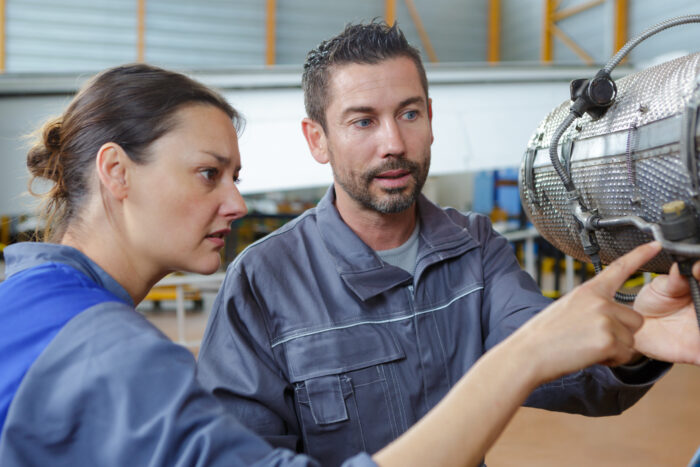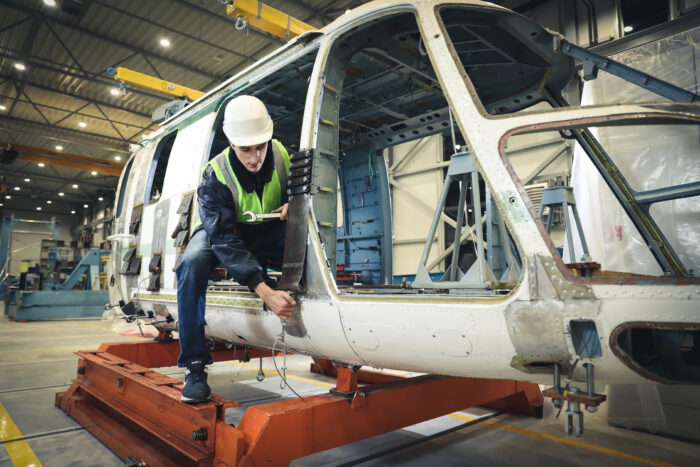We really enjoyed talking with Todd Bingham, CEO and President of the Utah Manufacturers Association (UMA). The UMA slogan is What Utah Makes, Makes Utah. UMA has been the leading alliance for the manufacturing community in Utah since 1905. It represents over 1200 manufacturing and service providers, big and small, in every inch of Utah.

UMA is the voice for the manufacturing community in Utah. UMA is instrumental in advocating for the business interests of the manufacturing community at the Utah state legislature.
Bingham has been part of the manufacturing world for decades and knows the industry better than almost anyone in Utah. The last few years have proven extremely volatile in the business sector. We discuss what is happening right now in the manufacturing world, but also how the industry came together and pivoted during the pandemic.
Q: Tell us about the current state of manufacturing in Utah. What is going on right now?
A: It’s been an interesting couple of years. Obviously, when we went into COVID, everything came to a grinding halt. Historically, Utah has been slow to go into recessions and very quick to come out. We did that in 2008 and 2009. The same thing kind of happened with COVID. I mean the world kind of stopped with supply chain. Everything came to a grinding halt in terms of getting products, goods, parts, components, pieces, things like that and then when we came out of it by the the fall of 2020 when things kind of started to open back up, our companies were just absolutely bursting at the seams and they have been that way ever since.
We are just starting to see the supply chain loosening up a bit. It’s a challenge. During COVID we saw some companies that had their best years ever. Those would be companies that perhaps did things like outdoor products and things where people thought I can’t fly in a plane, so I’m going to buy a barbeque or I’m going to put a play set in the backyard or I’m going to buy a new hot tub. At one point, hot tubs like Bullfrog Spa hot tubs were six months out. You could buy it and then had to wait 6 months for it to be built.
Q: What is the biggest challenge manufacturers are facing?
A: I’m sure our biggest challenge, by far, is not supply chain, it’s talent. It’s the ability to find talent and workforce not only at talent acquisition, but talent retention as well.
Q: Tell us about the current challenge of finding and retaining talent?
A: When we talked to our Board of Directors, which is about 40 manufacturing companies across the state, about three years ago, we asked how many empty spots do you have currently? We estimated that we hit about 3,000 vacancies in the room. Compare that to current numbers, where we are somewhere north of 10,000-12,000 vacancies conservatively just in manufacturing. What that means in terms of economic output is staggering.

A lot of companies are investing in automation and I think that will continue. Everyone knows there are just not enough people.
However, large parts of manufacturing arguably may never be automated, there’s certain parts that never will be, so acquiring talent is a challenge.
Utah has the highest birth rate and the largest family size in the nation, along with the lowest median age in the country. If Utah can’t solve the problem, I am not sure who can.
It is critical that we start building talent now. That involves veterans and repeat offenders; we’ve got to start looking at second chance hiring. We have a piece of legislation that passed this year that reduces liability for individuals that hire second chance individuals. Immigration reform is needed at a big level. We need a legal means to bring individuals from outside the country into work in these areas.
Q: Tell us about the scope of manufacturing in Utah.
A: We kind of fly under the radar a little bit in terms of manufacturing here in Utah. Sometimes people have an old school thought of big smokestacks and steel mills and things like that. That’s certainly a component part of it, but we manufacture a lot of different things. I don’t think many people are aware that here in Utah we have a very vibrant Aerospace industry. In fact, it is world renowned.
Just last week I was at Northrop Grumman’s rocket test fire for the Artemis. It is the UH-2 project up in Promontory, where they did a 2 minute and six second test of the rocket boosters for NASA. I found out we build the tail sections of the 787 Dreamliner here. We build all of the fuselage pieces for the A320. For the Airbus, we’ve got several projects out. Utah manufacturers are doing projects for SpaceX, NASA, and many more.
Utah also has a vibrant medical and bio life science industry. We do a lot of surgical and medical products with companies like Merit Medical and BD.
We also have a pretty vibrant food manufacturing – everyone from Gossner’s Foods in Logan to Pepperidge Farms.

Q: What is the coolest thing made in Utah?
A: Well, each year we hold a contest called Coolest Thing Made in Utah. We let the public decide what the coolest thing made in Utah is. Many times people don’t realize that manufacturing is directly related to your quality of life. Everything around you is manufactured and created. We are lucky to have such a wide range of things here. There are some very unique items on the list, including the number one recognized bowling ball in the world, according to The Professional Bowlers Association. It’s made in Brigham City.
Q: What does UMA do?
A: We want to be an extension of our manufacturing company’s offices. We don’t know everything, but we do know where to find the answer. We are great at connecting people and companies. So, whether it is a company looking for a piece of machinery or they are looking for a partner for a project; we help connect them to someone that has the right certifications, qualifications and equipment.
We started in 1905 as an organization really focused on governmental affairs in protecting the business climate in Utah. We have always tried to make sure that our manufacturers can continue to operate. They work best when they can keep their heads down and focus on what they do. We focus on making sure we keep a positive business climate.
Q: What are you doing to attract more companies and manufacturers to Utah?
A: We are continually looking at policies that drive manufacturing growth and why businesses choose to be here. Utah has been recognized by Forbes and many other organizations over the years as being the number one place to do business. The only problem is, there are 49 other states trying to take that title. So it’s something we are always aware of and working on.
Q: Tell us about your experience up at the Capitol and what you focus your energy on.
A: I’m going into my 28th session at the legislature. I focus on what we are doing to draw manufacturers here to Utah. Then we talk about keeping them here, keeping them happy and how that all ties together. Our Board of Directors is all manufacturers, so when we look at something from a policy perspective, it is people from the manufacturing world. We work with a very pro-business legislature and Governor. Often, we set priorities in terms of business climate and helping them not do something unintentionally. Policy is always going to be the driving force of the Utah Manufacturers Association.
Q: Do UMA members appreciate having their voices heard in government without having to directly participate?
A: Whether our companies realize it or not, and we think they generally do, the statement is, “either get into politics or get out of business”. They are most profitable and beneficial when they are focused on creating their own products and services, they’re not lobbyists. They don’t want to be lobbyists, so they rely on us to play in that arena.
Q: What have manufacturers learned from the volatility of the last few years?
A: One of the things we found out in COVID was how many gaps there are in our supply chain globally. I recently heard Gene Seroka speak. Gene is the director of the Port of Los Angeles. I spent two hours listening to Gene talk about the evolution of the largest port in the United States since COVID, and how that process works. We went from 2020 levels of ecommerce to 2026 levels projected overnight. That’s why there were thousands of container ships off the coast of California. They were trying to get product in. We also stopped the world in terms of production for a period of time. To get that engine back up and running is a significant challenge. I don’t believe we are going to see a significant recovery from the supply chain challenge till probably third quarter 2023. Everything has a domino effect.
Q: What are some misconceptions about the manufacturing industry?
A: We are trying to change the image of manufacturing that much of the public has – that it is dark, dirty and dangerous. This is no longer your grandfather’s manufacturing industry – it is high tech. It is clean and we are producing amazing products.
We’ve partnered with a group called STEM Heads. It was started by 11-year-old Liam Brown. He interviews CEOs of manufacturing companies and learns about what they make. Those companies give donations to fund scholarships to students who are going to pursue STEM careers.
We’re trying to help the public understand what careers are out there. In manufacturing, we can’t rely on people just stumbling into this industry, we’ve got to have a clear path and direction to acquire talent.
Q: Tell us what you have seen positively since COVID?
A: The ability of our companies to pivot during COVID. I think it is maybe a little known fact that we, as an organization, oversaw the making of 2.1 million masks during the pandemic and our companies in the state of Utah pivoted from making Letterman jackets and air bags and t-shirts and apparel and other things to making masks that we delivered to the state. We built about 2.1 million masks in three months and we were pretty pleased and impressed with doing that. The second thing was that we had medical device companies and other companies that produced large amounts of hand sanitizer to be to supply Utah with hand sanitizer and masks, which was something that those companies never thought they would do, but it shows the the talent, the versatility, and the flexibility of manufacturers.
Just recently, we spent a lot of time talking about the formula shortage. I would say that if it were not for FDA restriction we could pivot and produce a formula within about a four-day period here in the state of Utah with several companies and solve that problem.
When we talk about regulation, those are the types of things that we look at. Industry is very flexible and we are certainly capable of pivoting and doing amazing things. I’m proud of those companies that did an amazing job that just said all right, we’re going to stop making medical products and we’re going to start making this. They made test kits for COVID, they did everything. It was super impressive.
Secondly, would be the amount of expertise and technology that we have in Utah related to SpaceX, NASA, and aerospace things like that. I think you are going to see Utah in the next 10 years become even more of a force on high tech.
Thank you, Todd, for taking the time to talk to us. You can find out more about UMA here. If you would like more information about Diversified, you can find it here.
You can follow Todd on LinkedIn here.
Expert Bio
Todd R. Bingham, joined the Utah Manufacturers Association a 117 year old manufacturing organization as President/ CEO in 2012. Prior to UMA, he was the President/CEO of the Utah Mining Association. He has been a registered lobbyist in the state of Utah for more than 27 years, representing business and industry in the areas of public policy. Todd has served on several boards including the Governor’s Economic Council, Utah Employers Council, the Utah Labor Commission, The Utah OSHA Advisory Board, the Great Salt Lake Advisory Council, the Governors Rural Partnership Board and the Utah Air Quality Policy Advisory Board and the Board of Director of the National Association of Manufacturers (NAM)
Todd has been married for nearly 30 years to the former Jennifer Smart. They have three boys a wonderful daughter in law and the cutest grandson in the world.

